Stan C. Smith's Blog, page 14
May 12, 2023
Awesome Animal Fact - Disguised Moth
Did you know the hornet moth looks so much like a hornet that predators refuse to attack it? These large moths live in Europe and the Middle East, as well as in North America, where they have been introduced by humans.
This is a terrific example of what is called Batesian mimicry (when a harmless animal has evolved to look or behave like a dangerous animal as a form of protection).
This moth has taken this mimicry thing to a whole new level—when disturbed, it flies in a jerky motion, like a real hornet does. And its wings are even clear, like a hornet's wings.
As you can guess, these moths don't have a stinger and are completely harmless. But sometimes just looking and acting mean is enough. Most predators aren't willing to risk getting stung, so they leave this moth alone.
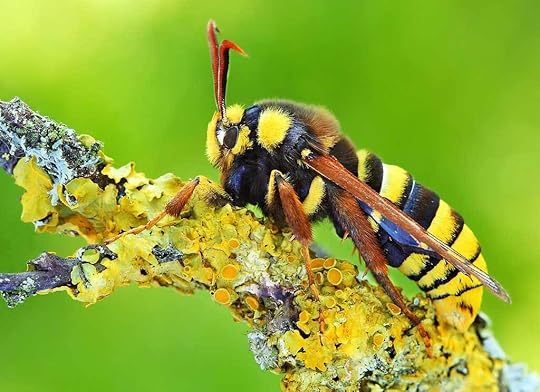
Photo Credits:
- Hornet Moth - Lukas Jonaitis from Vilnius, Lithuania, CC BY 2.0, via Wikimedia Commons
This is a terrific example of what is called Batesian mimicry (when a harmless animal has evolved to look or behave like a dangerous animal as a form of protection).
This moth has taken this mimicry thing to a whole new level—when disturbed, it flies in a jerky motion, like a real hornet does. And its wings are even clear, like a hornet's wings.
As you can guess, these moths don't have a stinger and are completely harmless. But sometimes just looking and acting mean is enough. Most predators aren't willing to risk getting stung, so they leave this moth alone.

Photo Credits:
- Hornet Moth - Lukas Jonaitis from Vilnius, Lithuania, CC BY 2.0, via Wikimedia Commons
Published on May 12, 2023 07:37
May 7, 2023
Awesome Animal Fact - Hungry Shrew
Did you know the pygmy shrew can eat one and a quarter of its own body weight in one meal? They often eat three times their body weight every day.
These voracious little predators weigh less than an ounce, but they make up for it in fierceness and appetite. They hunt and eat spiders, insects, and isopods (woodlice).
Pygmy shrews are alway hungry, and they eat every 15 to 30 minutes, day and night. Their metabolism is so high that if they go a whole hour without eating, they will die. And they can't survive in temperatures above 77º F (25º C). There are two species, one in the northern parts of North America, the other in northern Europe and Asia.
These little shrews have the fastest heartbeat (1,200 beats per minute) of any mammal. They also have one of the shortest life spans (11 to 13 months). It's life in the fast lane for pygmy shrews. No time for resting, which is why they never sleep more than a few minutes at a time.
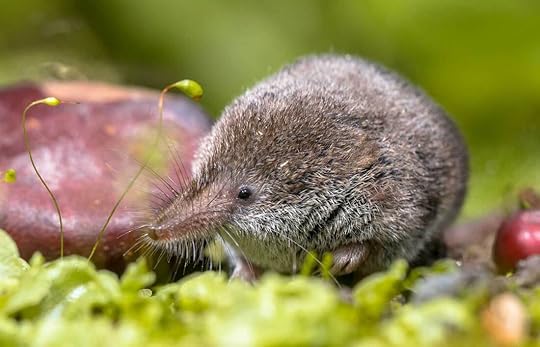
Photo Credits:
- Pygmy shrew - DepositPhotos
These voracious little predators weigh less than an ounce, but they make up for it in fierceness and appetite. They hunt and eat spiders, insects, and isopods (woodlice).
Pygmy shrews are alway hungry, and they eat every 15 to 30 minutes, day and night. Their metabolism is so high that if they go a whole hour without eating, they will die. And they can't survive in temperatures above 77º F (25º C). There are two species, one in the northern parts of North America, the other in northern Europe and Asia.
These little shrews have the fastest heartbeat (1,200 beats per minute) of any mammal. They also have one of the shortest life spans (11 to 13 months). It's life in the fast lane for pygmy shrews. No time for resting, which is why they never sleep more than a few minutes at a time.

Photo Credits:
- Pygmy shrew - DepositPhotos
Published on May 07, 2023 06:33
April 27, 2023
Awesome Animal Fact - Tireless Godwit
Did you know the bar-tailed godwit stuffs itself with food until it adds enough fat to double its weight?
The bar-tailed godwit, which is related to sandpipers, curlews, and snipe, feeds on insects, mollusks, and bristle-worms to fatten itself up for its phenomenal annual migration, growing from one pound to two pounds. Why do I call the migration phenomenal? Because these birds migrate from Alaska to New Zealand without stopping once to rest or to eat. The journey is over 7,000 miles (11,265 km), and the godwit must fly about 10 days and nights to get there.
No rest, no food. For 10 days of constant flying, even through storms and wind. This is the longest non-stop flight of any land birds in the world (some sea birds, like albatrosses, can stay in the air longer).
As a godwit prepares for its incredible 10-day journey, its body goes through a shape-shifting transition. Its gizzard, kidneys, and liver shrink in size to reduce weight, and its pectoral muscles grow to increase strength and endurance. The only excess baggage is the fat the bird will burn during the flight.

Photo Credits:
- Bar-tailed godwit - DepositPhotos
The bar-tailed godwit, which is related to sandpipers, curlews, and snipe, feeds on insects, mollusks, and bristle-worms to fatten itself up for its phenomenal annual migration, growing from one pound to two pounds. Why do I call the migration phenomenal? Because these birds migrate from Alaska to New Zealand without stopping once to rest or to eat. The journey is over 7,000 miles (11,265 km), and the godwit must fly about 10 days and nights to get there.
No rest, no food. For 10 days of constant flying, even through storms and wind. This is the longest non-stop flight of any land birds in the world (some sea birds, like albatrosses, can stay in the air longer).
As a godwit prepares for its incredible 10-day journey, its body goes through a shape-shifting transition. Its gizzard, kidneys, and liver shrink in size to reduce weight, and its pectoral muscles grow to increase strength and endurance. The only excess baggage is the fat the bird will burn during the flight.

Photo Credits:
- Bar-tailed godwit - DepositPhotos
Published on April 27, 2023 12:01
April 20, 2023
Awesome Animal Fact - Cannibal Tadpole
Did you know spadefoot toad tadpoles can transform into cannibals when they need to? Spadefoot toads, which are native to North America, often lay their eggs in temporary water puddles. There is always a risk that these puddles could dry up, killing the tadpoles.
As an adaptation to these temporary-puddle conditions, spadefoot toad tadpoles have the ability to switch from an omnivorous form (eating mostly plankton) to a carnivorous form (eating shrimp and other tadpoles, including their own species). You see, when a puddle begins to dry up, the space becomes increasingly crowded, without enough plankton to support the tadpoles. It also becomes really important for the tadpoles to accelerate their development, to become air-breathing adults before the water is gone.
So, a drying puddle triggers biological changes in the tadpoles' bodies. Their heads become larger, with larger, stronger jaw muscles. Their mouths become sharp beaks. Their intestines become shorter (carnivores have shorter intestines compared to herbivores because animal matter is easier to digest than plant matter). They become vicious predators.
This switch to a carnivorous, cannibalistic diet allows the tadpoles to take in more calories, which speeds up their transition into air-breathing adults. Below is a spadefoot tadpole metamorphosing into an adult.

Photo Credits:
- Spadefoot toad tadpole - Bernard DUPONT from FRANCE, CC BY-SA 2.0, via Wikimedia Commons
As an adaptation to these temporary-puddle conditions, spadefoot toad tadpoles have the ability to switch from an omnivorous form (eating mostly plankton) to a carnivorous form (eating shrimp and other tadpoles, including their own species). You see, when a puddle begins to dry up, the space becomes increasingly crowded, without enough plankton to support the tadpoles. It also becomes really important for the tadpoles to accelerate their development, to become air-breathing adults before the water is gone.
So, a drying puddle triggers biological changes in the tadpoles' bodies. Their heads become larger, with larger, stronger jaw muscles. Their mouths become sharp beaks. Their intestines become shorter (carnivores have shorter intestines compared to herbivores because animal matter is easier to digest than plant matter). They become vicious predators.
This switch to a carnivorous, cannibalistic diet allows the tadpoles to take in more calories, which speeds up their transition into air-breathing adults. Below is a spadefoot tadpole metamorphosing into an adult.

Photo Credits:
- Spadefoot toad tadpole - Bernard DUPONT from FRANCE, CC BY-SA 2.0, via Wikimedia Commons
Published on April 20, 2023 10:51
April 12, 2023
Awesome Animal Fact - Aggressive Larva
Did you know the larvae of two species of ground beetles eat amphibians, instead of the other way around? This is an interesting example of predator-prey reversal.
The ground beetle larva moves its antennae back and forth to attract the much larger amphibians (frogs, toads, or salamanders). Thinking the beetle larva is prey, the frog attacks. Using its strong jaws, the larva latches onto the frog anywhere it can get a grip, often the frog's tongue. Then the larva uses a "sewing movement" of its jaws to work its way around the frog's body to a spot where it can chew through the skin and disable the frog. The larva's jaws are so strong that the frog is unable to pull it loose.
Once the frog is disabled from the damage, the beetle larva then sucks the frog's blood for about a week. When the blood is drained, the larva starts chewing, eating the frog until only bones remain.
Hmm... this may sound kind of awful, but keep in mind that frogs, toads, and salamanders eat hundreds of beetles during their lifetimes. So, just consider this payback.
The photo shows a ground beetle larva attacking a European green toad.

The ground beetle larva moves its antennae back and forth to attract the much larger amphibians (frogs, toads, or salamanders). Thinking the beetle larva is prey, the frog attacks. Using its strong jaws, the larva latches onto the frog anywhere it can get a grip, often the frog's tongue. Then the larva uses a "sewing movement" of its jaws to work its way around the frog's body to a spot where it can chew through the skin and disable the frog. The larva's jaws are so strong that the frog is unable to pull it loose.
Once the frog is disabled from the damage, the beetle larva then sucks the frog's blood for about a week. When the blood is drained, the larva starts chewing, eating the frog until only bones remain.
Hmm... this may sound kind of awful, but keep in mind that frogs, toads, and salamanders eat hundreds of beetles during their lifetimes. So, just consider this payback.
The photo shows a ground beetle larva attacking a European green toad.

Published on April 12, 2023 03:59
Awesome Animal Fact - Smallest Snake
Did you know the Barbados threadsnake is the smallest snake in the world?
The average length of this snake is only 3.9 inches (10 cm).
The Barbados threadsnake was identified in 2008 by herpetologist S. Blair Hedges. It is only found on the Caribbean islands of Barbados and Anguilla. Hedges described this snake as "about as wide as a spaghetti noodle."
Scientists think this is about as small as snakes can possibly get. Why? Because all snakes are predators, and baby snakes have to be a certain size to be able to find and overpower the appropriate prey animals. Because of the small size of adult threadsnakes, and the need for the babies to be a certain minimum size, the females lay only one egg, which is huge in proportion to the adult female's body. When the baby hatches, it can already be half the length of the adult female.
Here is a romantic aspect of this: Hedges named the snake Tetracheilostoma carlae, in honor of his wife Carla Ann Hass, who also happens to be a herpetologist. If I ever discover a new species of snake, I'll name it in honor of Trish.

Photo Credits:
- Barbados threadsnake - Blair Hedges, Penn State, Attribution, via Wikimedia Commons
The average length of this snake is only 3.9 inches (10 cm).
The Barbados threadsnake was identified in 2008 by herpetologist S. Blair Hedges. It is only found on the Caribbean islands of Barbados and Anguilla. Hedges described this snake as "about as wide as a spaghetti noodle."
Scientists think this is about as small as snakes can possibly get. Why? Because all snakes are predators, and baby snakes have to be a certain size to be able to find and overpower the appropriate prey animals. Because of the small size of adult threadsnakes, and the need for the babies to be a certain minimum size, the females lay only one egg, which is huge in proportion to the adult female's body. When the baby hatches, it can already be half the length of the adult female.
Here is a romantic aspect of this: Hedges named the snake Tetracheilostoma carlae, in honor of his wife Carla Ann Hass, who also happens to be a herpetologist. If I ever discover a new species of snake, I'll name it in honor of Trish.

Photo Credits:
- Barbados threadsnake - Blair Hedges, Penn State, Attribution, via Wikimedia Commons
Published on April 12, 2023 03:57
Awesome Animal Fact - Biggest Snake
Did you know the Titanoboa was the largest snake to ever live? We know from fossils that these amazing snakes were at least 48 feet (14.6 m) long and are estimated to have weighed about 3,300 pounds (1,500 kg).
For comparison, the largest living snakes today are the reticulated python (the longest, up to 32 feet) and the green anaconda (the heaviest, up to 500 pounds).
Titanoboas lived in Central and South America about 60 million years ago, which was after most of the dinosaurs went extinct. These snakes lived in what scientists believe was the first real rainforest on Earth.
Consider this: The horror movie Anaconda (starring Jennifer Lopez and Ice Cube) was released in 1997. The giant snake in the movie was 40 feet long. Fossils of Titanoboa were not discovered until at least five years after the movie was released, and Titanoboa was at least 8 feet longer than the ridiculously large anaconda of the movie. Let that sink in for a moment.
Below is a scientifically accurate model of Titanoboa on display at the Smithsonian museum in Washington DC. The snake is swallowing a crocodile.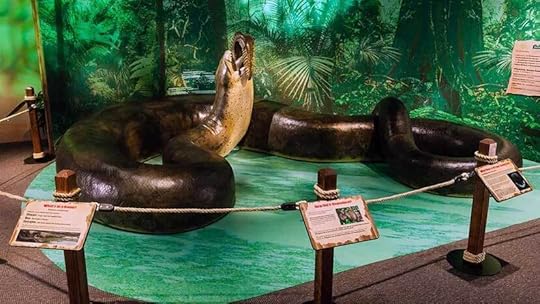
For comparison, the largest living snakes today are the reticulated python (the longest, up to 32 feet) and the green anaconda (the heaviest, up to 500 pounds).
Titanoboas lived in Central and South America about 60 million years ago, which was after most of the dinosaurs went extinct. These snakes lived in what scientists believe was the first real rainforest on Earth.
Consider this: The horror movie Anaconda (starring Jennifer Lopez and Ice Cube) was released in 1997. The giant snake in the movie was 40 feet long. Fossils of Titanoboa were not discovered until at least five years after the movie was released, and Titanoboa was at least 8 feet longer than the ridiculously large anaconda of the movie. Let that sink in for a moment.
Below is a scientifically accurate model of Titanoboa on display at the Smithsonian museum in Washington DC. The snake is swallowing a crocodile.

Published on April 12, 2023 03:54
March 26, 2023
Awesome Creepy Plant - Smelly Corpse Flower
Did you know the titan arum flower smells like a rotting corpse? This plant (Amorphophallus titanum) is also called the corpse flower or carrion flower. As the enormous flower blooms, it gives off a strong scent people often describe as similar to rotting meat.
The plant has evolved this particular scent because it attracts its main pollinators, including carrion beetles and flesh flies that normally feed on animal carcasses. This plant is native to the rainforests on the island of Sumatra (in Indonesia).
Although the blooming portion looks like one huge flower, it is actually a massive cluster of tiny flowers, called an inflorescence. It is the largest non-branching inflorescence in the world. The "flower" itself grows to 3 meters (10 feet) tall.
Interestingly, you can buy seeds for this plant at Amazon. Keep in mind, though, that it takes about ten years for one "flower" to bloom!
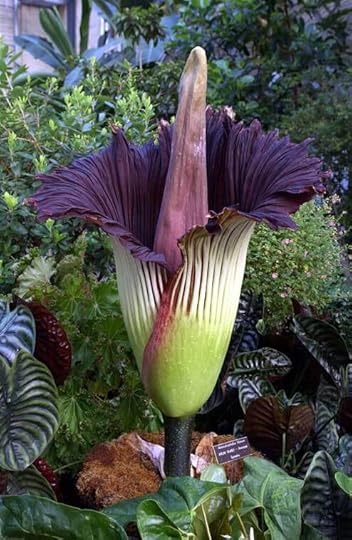
Photo Credits:
- Corpse flower - Credits: US Botanic Garden., Public domain, via Wikimedia Commons
The plant has evolved this particular scent because it attracts its main pollinators, including carrion beetles and flesh flies that normally feed on animal carcasses. This plant is native to the rainforests on the island of Sumatra (in Indonesia).
Although the blooming portion looks like one huge flower, it is actually a massive cluster of tiny flowers, called an inflorescence. It is the largest non-branching inflorescence in the world. The "flower" itself grows to 3 meters (10 feet) tall.
Interestingly, you can buy seeds for this plant at Amazon. Keep in mind, though, that it takes about ten years for one "flower" to bloom!

Photo Credits:
- Corpse flower - Credits: US Botanic Garden., Public domain, via Wikimedia Commons
Published on March 26, 2023 04:20
March 22, 2023
Awesome Creepy Plant - Snapdragon Skulls
Did you know snapdragon seed pods look like tiny human skulls? Yeah, it's just a random trick of nature, but you have to admit it's pretty cool.
Snapdragons are native to rocky areas of Europe, the United States, and North Africa. They got their name because when you squeeze the sides of a flower with your fingers, the flower appears to be a creature opening and closing its mouth.
In Asia, snapdragons are often called rabbit’s lips, and in Holland they are called lion’s lips. People have been cultivating snapdragons since the 1700s. They make great garden flowers, and they attract butterflies and bees.
Not surprisingly, snapdragons were important in historical folklore, including the belief that they offer protection from witchcraft.
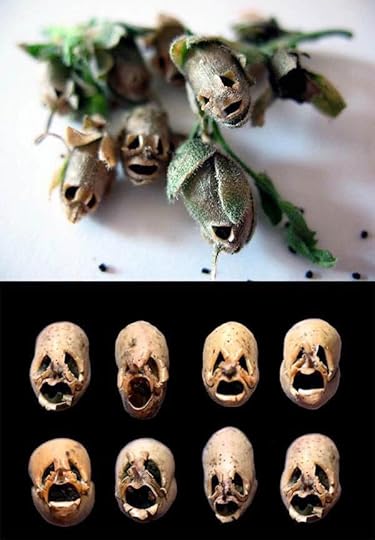
Snapdragons are native to rocky areas of Europe, the United States, and North Africa. They got their name because when you squeeze the sides of a flower with your fingers, the flower appears to be a creature opening and closing its mouth.
In Asia, snapdragons are often called rabbit’s lips, and in Holland they are called lion’s lips. People have been cultivating snapdragons since the 1700s. They make great garden flowers, and they attract butterflies and bees.
Not surprisingly, snapdragons were important in historical folklore, including the belief that they offer protection from witchcraft.

Published on March 22, 2023 06:30
March 19, 2023
Awesome Creepy Plant Fact - Eyes of the Amazon
I have a few Awesome Creepy Plant Facts to share with you. Here's the first one. Did you know the seeds of the guaraná plant look like a bunch of eyeballs staring out at the world? Sometimes this plant is called "eyes of the Amazon."
Of course this resemblance is purely coincidental.
Native to the Amazon basin in Brazil, guaraná seeds contain a lot of caffeine—four times that of coffee beans. It also contains other psychoactive stimulants (including saponins and tannins) associated with improved cognitive performance. And, as if that weren't impressive enough, it has been researched extensively because of its ability to prevent cardiovascular disease, as an anti-inflammatory, antioxidant, antidepressant, intestinal regulator, and even an aphrodisiac. Definitely a super food!
Not surprisingly, the plant has long been important to the indigenous people of the area where it grows. The Sateré-Mawé people have been cultivating guaraná in their ancestral forests for thousands of years. They have an oral legend that describes how their people are descended from a murdered child, whose eye was buried and grew into the first guaraná, then the first Sateré-Mawé person emerged from that plant.
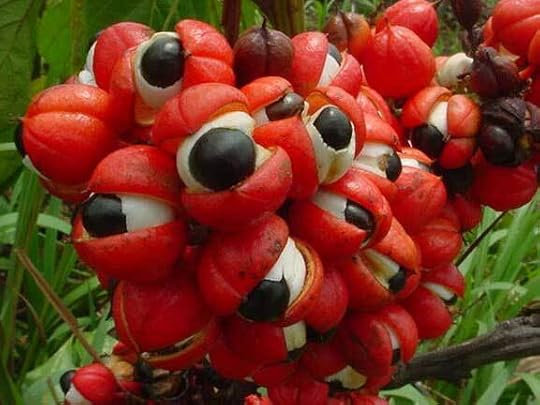
Photo Credits:
- Guaraná seeds - AnitaFortis, CC BY-SA 3.0, via Wikimedia Commons
Of course this resemblance is purely coincidental.
Native to the Amazon basin in Brazil, guaraná seeds contain a lot of caffeine—four times that of coffee beans. It also contains other psychoactive stimulants (including saponins and tannins) associated with improved cognitive performance. And, as if that weren't impressive enough, it has been researched extensively because of its ability to prevent cardiovascular disease, as an anti-inflammatory, antioxidant, antidepressant, intestinal regulator, and even an aphrodisiac. Definitely a super food!
Not surprisingly, the plant has long been important to the indigenous people of the area where it grows. The Sateré-Mawé people have been cultivating guaraná in their ancestral forests for thousands of years. They have an oral legend that describes how their people are descended from a murdered child, whose eye was buried and grew into the first guaraná, then the first Sateré-Mawé person emerged from that plant.

Photo Credits:
- Guaraná seeds - AnitaFortis, CC BY-SA 3.0, via Wikimedia Commons
Published on March 19, 2023 06:23



